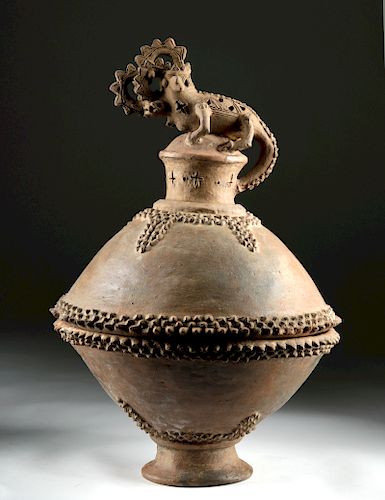Exhibited Costa Rican Pottery Zoomorphic Incensario
Lot 145b
About Seller
Artemis Fine Arts
686 S Taylor Ave, Ste 106
Louisville, CO 80027
United States
Selling antiquities, ancient and ethnographic art online since 1993, Artemis Gallery specializes in Classical Antiquities (Egyptian, Greek, Roman, Near Eastern), Asian, Pre-Columbian, African / Tribal / Oceanographic art. Our extensive inventory includes pottery, stone, metal, wood, glass and textil...Read more
Estimate:
$15,000 - $20,000
Absentee vs Live bid
Two ways to bid:
- Leave a max absentee bid and the platform will bid on your behalf up to your maximum bid during the live auction.
- Bid live during the auction and your bids will be submitted real-time to the auctioneer.
Bid Increments
| Price | Bid Increment |
|---|---|
| $0 | $25 |
| $300 | $50 |
| $1,000 | $100 |
| $2,000 | $250 |
| $5,000 | $500 |
| $10,000 | $1,000 |
| $20,000 | $2,500 |
| $50,000 | $5,000 |
| $100,000 | $10,000 |
| $200,000 | $20,000 |
About Auction
By Artemis Fine Arts
Feb 21, 2019
Set Reminder
2019-02-21 10:00:00
2019-02-21 10:00:00
America/New_York
Bidsquare
Bidsquare : Exceptional Antiquities, Asian, Ethnographic
https://www.bidsquare.com/auctions/artemis-gallery/exceptional-antiquities-asian-ethnographic-3858
An important one-day auction featuring museum-worthy examples of Egyptian, Greek, Roman, Etruscan, Near Eastern, Far East / Asian, Pre-Columbian, African / Tribal, Oceanic, Native American, Spanish Colonial, Russian, Fossils, Ancient Jewelry, Fine Art, so much more! Artemis Fine Arts info@artemisfinearts.com
An important one-day auction featuring museum-worthy examples of Egyptian, Greek, Roman, Etruscan, Near Eastern, Far East / Asian, Pre-Columbian, African / Tribal, Oceanic, Native American, Spanish Colonial, Russian, Fossils, Ancient Jewelry, Fine Art, so much more! Artemis Fine Arts info@artemisfinearts.com
- Lot Description
Pre-Columbian, Central America, Costa Rica, Guanacaste / Nicoya, Potosi, ca. 600 to 1100 CE. A fabulous hand-built pottery incensario of an enormous size. The two-part vessel consists of a lower body presenting a wide conical basin resting atop a concave splayed foot and a similarly-shaped lid with a raised neck collar and a cylindrical spout, with the rims of each lined with applied conical nodules. Serving as the handle atop the lid is a fantastical crocodilian creature known as a saurian with a scaly, openwork body, a quartet of stocky legs, a sinuous tail with three parallel lines of spikes, and four highly-stylized horns/tusks which curl vertically over its head. The deep basin is large enough to contain substantial amounts of copal or other aromatic substances, and five incised crosses act as vent holes around the neck for the scented smoke to escape once the incensario lid is closed. Size (w/ lid): 16.75" W x 25.25" H (42.5 cm x 64.1 cm).
The iconography on these pieces is especially symbolic. Sauria refer to a class of reptiles that originally included lizards, crocodiles, and other extinct lizard-like forms. Serpents and lizards were metaphors for rain and blood, two life-giving fluids, in the Pre-Columbian world. At the same time, serpents were viewed as creatures that portend great danger. Their ability to shed their skin each year, and thus rejuvenate themselves, also made them a symbol of health and renewal. The Crocodilian order, comprised of crocodiles, smaller alligators, and yet smaller caymans (all treated similarly in Pre-Columbian mythology) was very meaningful to the ancients of the Americas. The crocodile being the oldest (approximately 55 million years old) was understood as a crocodilian earth monster and is oftentimes shown giving rise to what was known as the World Tree. Partial to a watery habitat, the crocodile is also a metaphor for fertility.
For some stylistically-similar examples, please see: Abel-Vidor, Suzanne. "Between Continents/Between Seas: Precolumbian Art of Costa Rica." Harry N. Abrams, Inc., New York, 1981, p. 193, figs. 90, 91.
For another stylistically-similar example, please see The Walters Art Museum, accession number 2009.20.45: https://art.thewalters.org/detail/80200/crocodile-effigy-incense-burner/
Provenance: private Hawaii, USA collection; exhibited at the Everson Museum of Art, Syracuse, New York, USA
All items legal to buy/sell under U.S. Statute covering cultural patrimony Code 2600, CHAPTER 14, and are guaranteed to be as described or your money back.
A Certificate of Authenticity will accompany all winning bids.
We ship worldwide and handle all shipping in-house for your convenience.
#139305Base, lid, and handle professionally repaired from multiple large pieces with resurfacing and overpainting along break lines. Minor nicks and abrasions to foot, body, lid, and handle, with softening to some finer details, and light encrustations. Light earthen deposits throughout. Old inventory label beneath foot.Condition
- Shipping Info
-
All shipping is handled in-house for your convenience. Your invoice from Artemis Gallery will include shipping calculation instructions. If in doubt, please inquire BEFORE bidding for estimated shipping costs for individual items.
-
- Buyer's Premium



 EUR
EUR CAD
CAD AUD
AUD GBP
GBP MXN
MXN HKD
HKD CNY
CNY MYR
MYR SEK
SEK SGD
SGD CHF
CHF THB
THB


















